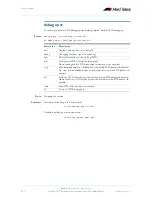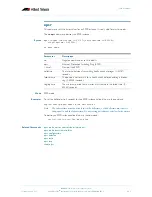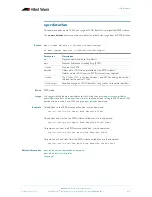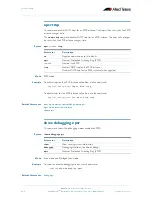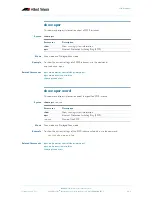
NTP Configuration
©2008 Allied Telesis Inc. All rights reserved.
50.2
AlliedWare Plus
TM
Operating System Software Reference C613-50003-00 REV E
Software Version 5.2.1
Introduction
This chapter describes the Network Time Protocol (NTP) service provided by the switch, and
how to configure and monitor NTP on the switch.
NTP is a protocol for synchronizing the time clocks on a collection of network devices using a
distributed client/server mechanism. NTP uses UDP (User Datagram Protocol) as the transport
mechanism. NTP evolved from the Time Protocol (RFC 868) and the ICMP Timestamp
message (RFC 792).
NTP provides protocol mechanisms to specify the precision and estimated error of the local
clock and the characteristics of the reference clock to which it may be synchronized.
Overview
NTP uses a subnetwork with primary reference clocks, gateways, secondary reference clocks,
and local hosts. These are organized into a hierarchy with the more accurate clocks near the
top and less accurate ones near the bottom.
A number of primary reference clocks, synchronized to national standards, are connected to
widely accessible resources (such as backbone gateways or switches) operating as primary time
servers. The primary time servers use NTP between them to crosscheck clocks, to mitigate
errors due to equipment or propagation failures, and to distribute time information to local
secondary time servers. The secondary time servers redistribute the time information to the
remaining local hosts.
The hierarchical organization and distribution of time information reduces the protocol
overhead, and allows selected hosts to be equipped with cheaper but less accurate clocks. NTP
provides information which organizes this hierarchy on the basis of precision or estimated
error.
■
An NTP entity may be in one of the following operating modes; however, the switch’s
implementation of NTP supports two modes: client and server.
■
An NTP entity operating in a client mode sends periodic messages to its peers, requesting
synchronization by its peers.
■
An NTP entity enters the server mode temporarily when it receives a client request
message from one of its peers, and remains in server mode until the reply to the request
has been transmitted.
■
An NTP entity operating in symmetric active mode sends messages announcing its
willingness to synchronize and be synchronized by its peers.
■
An NTP entity enters symmetric passive mode in response to a message from a peer
operating in Symmetric Active mode. An NTP entity operating in this mode announces its
willingness to synchronize and be synchronized by its peers.
■
An NTP entity operating in broadcast mode periodically sends messages announcing its
willingness to synchronize all of its peers but not to be synchronized by any of them.
The same message format is used for both requests and replies. When a request is received,
the server interchanges addresses and ports, fills in or overwrites certain fields in the message,
recalculates the checksum, and returns it immediately. The information included in the NTP
message allows each client/ server peer to determine the timekeeping characteristics of its
peers, including the expected accuracies of their clocks. Each peer uses this information and
selects the best time from possibly several other clocks, updates the local clock, and estimates
its accuracy.



